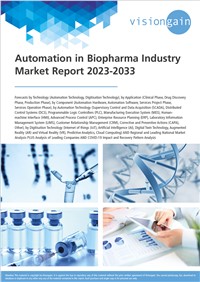The Automation in Biopharma Industry Market Report 2023-2033: This report will prove invaluable to leading firms striving for new revenue pockets if they wish to better understand the industry and its underlying dynamics. It will be useful for companies that would like to expand into different industries or to expand their existing operations in a new region.
Automation in biopharma industry is a term used to describe the use of advanced technologies and automated systems in the biopharmaceutical industry to enhance the manufacturing process’s efficiency, accuracy, and reliability. It can improve drug production’s consistency and quality through various means.
The primary advantage of biopharma automation is that it enhances accuracy and precision. Automated systems can be programmed to perform tasks with increased accuracy and precision, reducing the likelihood of errors and inconsistencies that may affect drug quality. Biopharma automation can also reduce the risk of contamination by reducing the need for human intervention, thereby improving product purity.
Another significant benefit of biopharma automation is improved efficiency. Automated systems can operate continuously and perform repetitive tasks much more quickly than humans, reducing manufacturing time and increasing productivity. This can result in significant cost savings and faster drug production.
Biopharma automation also provides enhanced process control. Automated systems can monitor and control manufacturing processes more closely, ensuring that critical process parameters are maintained within a narrow range. This can result in consistent product quality and a reduced risk of batch failures.
Overall, biopharma automation has numerous benefits in terms of increased efficiency, reduced risk of errors and contamination, and improved product quality and consistency, making it an essential tool in the biopharmaceutical industry.
What Questions Should You Ask before Buying a Market Research Report?
- How is the automation in biopharma industry market evolving?
- What is driving and restraining the automation in biopharma industry market?
- How will each automation in biopharma industry submarket segment grow over the forecast period and how much revenue will these submarkets account for in 2033?
- How will the market shares for each automation in biopharma industry submarket develop from 2023 to 2033?
- What will be the main driver for the overall market from 2023 to 2033?
- Will leading automation in biopharma industry markets broadly follow the macroeconomic dynamics, or will individual national markets outperform others?
- How will the market shares of the national markets change by 2033 and which geographical region will lead the market in 2033?
- Who are the leading players and what are their prospects over the forecast period?
- What are the automation in biopharma industry projects for these leading companies?
- How will the industry evolve during the period between 2023 and 2033? What are the implications of automation in biopharma industry projects taking place now and over the next 10 years?
- Is there a greater need for product commercialisation to further scale the automation in biopharma industry market?
- Where is the automation in biopharma industry market heading and how can you ensure you are at the forefront of the market?
- What are the best investment options for new product and service lines?
- What are the key prospects for moving companies into a new growth path and C-suite?
You need to discover how this will impact the automation in biopharma industry market today, and over the next 10 years:
- Our 396-page report provides 134 tables and 205 charts/graphs exclusively to you.
- The report highlights key lucrative areas in the industry so you can target them – NOW.
- It contains in-depth analysis of global, regional and national sales and growth.
- It highlights for you the key successful trends, changes and revenue projections made by your competitors.
This report tells you TODAY how the automation in biopharma industry market will develop in the next 10 years, and in line with the variations in COVID-19 economic recession and bounce. This market is more critical now than at any point over the last 10 years.
Forecasts to 2033 and other analyses reveal commercial prospects
- In addition to revenue forecasting to 2033, our new study provides you with recent results, growth rates, and market shares.
- You will find original analyses, with business outlooks and developments.
- Discover qualitative analyses (including market dynamics, drivers, opportunities, restraints and challenges), cost structure, impact of rising automation in biopharma industry prices and recent developments.
This report includes data analysis and invaluable insight into how COVID-19 will affect the industry and your company. Four COVID-19 recovery patterns and their impact, namely, “V”, “L”, “W” and “U” are discussed in this report.
Segments Covered in the Report
Technology
- Automation Technology
- Digitisation Technology
- Clinical Phase
- Drug Discovery Phase
- Production Phase
- Automation Hardware
- Automation Software
- Services Project Phase
- Services Operation Phase
- Supervisory Control and Data Acquisition (SCADA)
- Distributed Control Systems (DCS)
- Programmable Logic Controllers (PLC)
- Manufacturing Execution System (MES)
- Human-machine Interface (HMI)
- Advanced Process Control (APC)
- Enterprise Resource Planning (ERP)
- Laboratory Information Management System (LIMS)
- Customer Relationship Management (CRM)
- Corrective and Preventive Actions (CAPA)
- Other Automation Technologies
- Internet of things (IoT)
- Artificial Intelligence (AI)
- Digital Twin Technology
- Augmented Reality (AR) and Virtual Reality (VR)
- Predictive Analytics
- Cloud Computing
CTA
In addition to the revenue predictions for the overall world market and segments, you will also find revenue forecasts for four regional and 20 leading national markets:
North America
- U.S.
- Canada
- Germany
- UK
- France
- Italy
- Spain
- Rest of Europe
- China
- India
- Japan
- South Korea
- Australia
- Rest of Asia Pacific
- Brazil
- Mexico
- Rest of Latin America
- GCC
- South Africa
- Rest of Middle East & Africa



